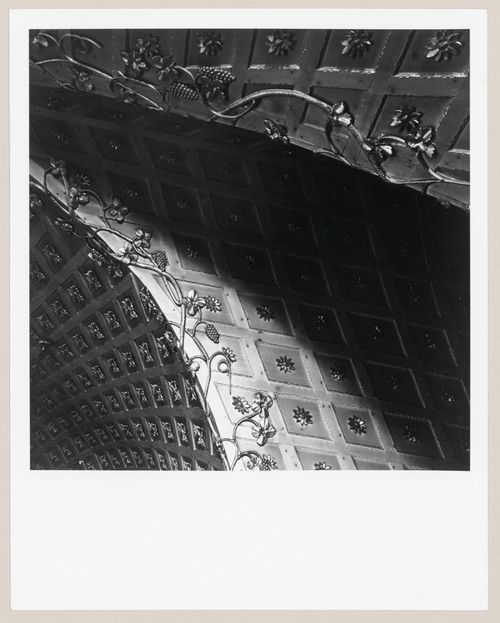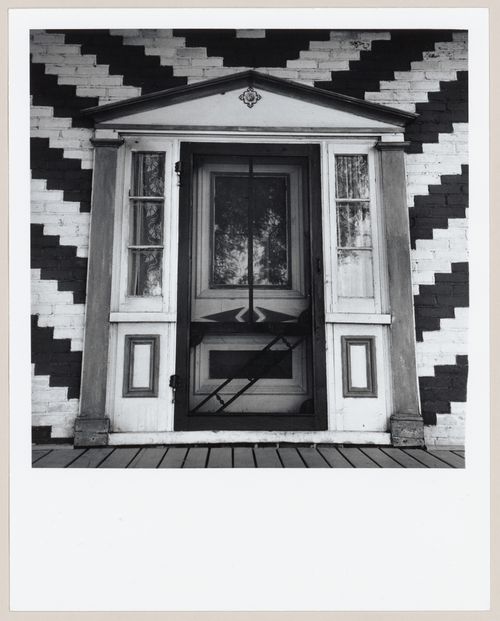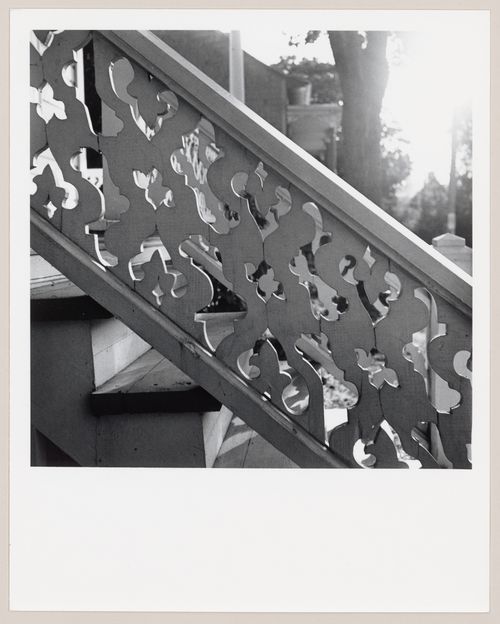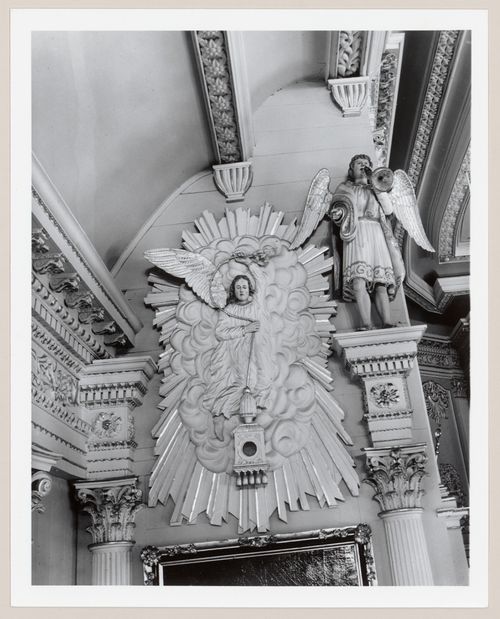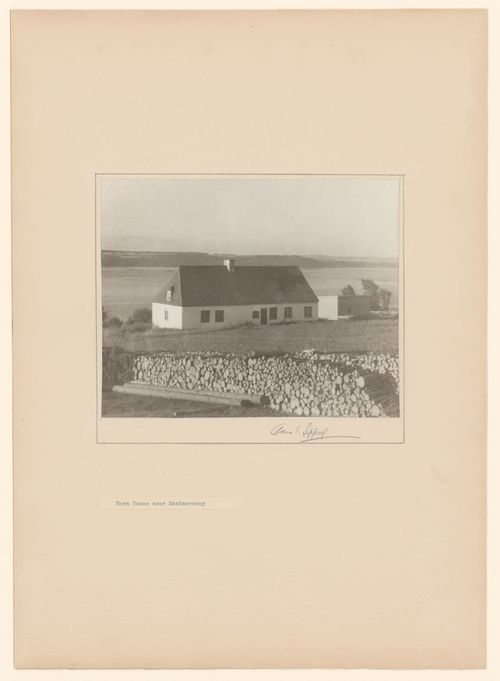PH1980:0515
Description:
- The constructed alternate title is the title that appeared on the label copy in the CCA exhibition "Parcours de photographes visiteurs au Québec: Sipprell, Moser, Volkerding et Kawamata" (see exhibition file "Four Photographers Visit Québec").
architecture, sculpture
1950
Détail de la voûte à caissons de l'église Saint-Jean-Baptiste, Saint-Jean-Port-Joli, Québec
Actions:
PH1980:0515
Description:
- The constructed alternate title is the title that appeared on the label copy in the CCA exhibition "Parcours de photographes visiteurs au Québec: Sipprell, Moser, Volkerding et Kawamata" (see exhibition file "Four Photographers Visit Québec").
architecture, sculpture
PH1980:0532
Description:
- The constructed alternate title is the title that appeared on the label copy in the CCA exhibition "Parcours de photographes visiteurs au Québec: Sipprell, Moser, Volkerding et Kawamata" (see exhibition file "Four Photographers Visit Québec").
architecture
1950
Entrée principale d'une maison, Ile d'Orléans, Québec
Actions:
PH1980:0532
Description:
- The constructed alternate title is the title that appeared on the label copy in the CCA exhibition "Parcours de photographes visiteurs au Québec: Sipprell, Moser, Volkerding et Kawamata" (see exhibition file "Four Photographers Visit Québec").
architecture
PH1980:0553
Description:
- The constructed alternate title is the title that appeared on the label copy in the CCA exhibition "Parcours de photographes visiteurs au Québec: Sipprell, Moser, Volkerding et Kawamata" (see exhibition file "Four Photographers Visit Québec").
architecture
1950
Détail des motifs d'une rampe d'escalier en bois, région de L'Islet-sur-Mer, Québec
Actions:
PH1980:0553
Description:
- The constructed alternate title is the title that appeared on the label copy in the CCA exhibition "Parcours de photographes visiteurs au Québec: Sipprell, Moser, Volkerding et Kawamata" (see exhibition file "Four Photographers Visit Québec").
architecture
PH1980:0557
Description:
- The constructed alternate title is the title that appeared on the label copy in the CCA exhibition "Parcours de photographes visiteurs au Québec: Sipprell, Moser, Volkerding et Kawamata" (see exhibition file "Four Photographers Visit Québec").
architecture, sculpture
1950
Sculptures ornant la chapelle latérale gauche de l'église Notre-Dame-de-Bonsecours, L'Islet-sur-Mer, Québec
Actions:
PH1980:0557
Description:
- The constructed alternate title is the title that appeared on the label copy in the CCA exhibition "Parcours de photographes visiteurs au Québec: Sipprell, Moser, Volkerding et Kawamata" (see exhibition file "Four Photographers Visit Québec").
architecture, sculpture
textual records
ARCH252277
Description:
-Fundraising kit given out to potential donors at Marie-Josee Kravis event (2) -IFCCA Prize for the Design of Cities poster -Description and conditions brochure (French and English) -Award dinner: hold the date card, invitation, dinner programme -Exhibition/Colloquium: poster, invitation, tabloid -press releases: 10 February (English, French), 28 June 1999 (English, French) -Media clippings kit
1998
Fundraising kit, IFCCA Prize for the Design of Cities poster, description and conditions brochure, media clippings kit
Actions:
ARCH252277
Description:
-Fundraising kit given out to potential donors at Marie-Josee Kravis event (2) -IFCCA Prize for the Design of Cities poster -Description and conditions brochure (French and English) -Award dinner: hold the date card, invitation, dinner programme -Exhibition/Colloquium: poster, invitation, tabloid -press releases: 10 February (English, French), 28 June 1999 (English, French) -Media clippings kit
textual records
1998
Project
AP148.S1.1970.PR02
Description:
The project series documents Poli's work on the Interplanetary Architecture project, which was also made into a film by Superstudio directed by Alessandro Poli (the film is not included in the fonds). The project reflects Poli's deep fascination with the moon landing in 1969. Poli uses this major media event as a catalyst for thinking about a new approach to architecture and tools for design, including the idea that film and the movie camera should become part of the toolset. The project also seems to be in some way a response to Epoch magazine's challenge for a "Primo concorso di architettura nello spazio" (the first architectural competition in space), and includes much imagery and textual references to a new road or architectural links between the earth and other planets, including an earth moon highway. In his storyboard, Poli also makes reference to his earlier Piper project, and some imagery features wheels and an amusement park. The Interplanetary Architecture project was exhibited by Superstudio in Rome in 1972 and featured in "Casabella" magazine in April 1972 (no. 364). The project was also featured in the 2010 CCA exhibition "Other Space Odysseys". In the accompanying CCA publication, Poli describes this project as "a voyage off earthbound routes in quest of architecture unfettered by the urban nightmare, by induced needs or by planning as the only tool for regulating and solving the world's problems" (Poli quoted in Borasi and Zardini, 2010, 110). Poli's work on this project is deeply tied to the Zeno project, which was also featured in this exhibition and is included in this fonds (see AP148.S1.1972.PR01). For the Zeno project, Poli envisioned a dialogue between astronaut Buzz Aldrin and an Italian peasant, Zeno of Riparbella. Poli felt that these two shared a similarity in that both their homes were isolated capsules, one that provided a lens from which to see the rest of the world and understand their place in it. The material in the series includes numerous photomontages and collages of astronauts in space, as well as drawings of plantery shapes and structures. There are also texts, some of which include calculations of distances and diameters of planets, as well as notebooks and sketchbooks, many of which Poli included in a folder he entitled "Storyboard." The series also includes an unsent letter from Poli to Adolfo Natalini which describes how, after the moon landing, everything - the planet, the moon, the stars - is architecture, and that this will necessitate the need for new design tools, such as the movie camera. Some works are signed Alessandro Poli-Superstudio. Source cited: Giovanna Borasi and Mirko Zardini, eds., Other Space Odysseys, Montreal and Baden: Canadian Centre for Architecture/Lars Müller Publishers, 2010.
1969-1971
Architettura Interplanetaria [Interplanetary Architecture] (1970-1971)
Actions:
AP148.S1.1970.PR02
Description:
The project series documents Poli's work on the Interplanetary Architecture project, which was also made into a film by Superstudio directed by Alessandro Poli (the film is not included in the fonds). The project reflects Poli's deep fascination with the moon landing in 1969. Poli uses this major media event as a catalyst for thinking about a new approach to architecture and tools for design, including the idea that film and the movie camera should become part of the toolset. The project also seems to be in some way a response to Epoch magazine's challenge for a "Primo concorso di architettura nello spazio" (the first architectural competition in space), and includes much imagery and textual references to a new road or architectural links between the earth and other planets, including an earth moon highway. In his storyboard, Poli also makes reference to his earlier Piper project, and some imagery features wheels and an amusement park. The Interplanetary Architecture project was exhibited by Superstudio in Rome in 1972 and featured in "Casabella" magazine in April 1972 (no. 364). The project was also featured in the 2010 CCA exhibition "Other Space Odysseys". In the accompanying CCA publication, Poli describes this project as "a voyage off earthbound routes in quest of architecture unfettered by the urban nightmare, by induced needs or by planning as the only tool for regulating and solving the world's problems" (Poli quoted in Borasi and Zardini, 2010, 110). Poli's work on this project is deeply tied to the Zeno project, which was also featured in this exhibition and is included in this fonds (see AP148.S1.1972.PR01). For the Zeno project, Poli envisioned a dialogue between astronaut Buzz Aldrin and an Italian peasant, Zeno of Riparbella. Poli felt that these two shared a similarity in that both their homes were isolated capsules, one that provided a lens from which to see the rest of the world and understand their place in it. The material in the series includes numerous photomontages and collages of astronauts in space, as well as drawings of plantery shapes and structures. There are also texts, some of which include calculations of distances and diameters of planets, as well as notebooks and sketchbooks, many of which Poli included in a folder he entitled "Storyboard." The series also includes an unsent letter from Poli to Adolfo Natalini which describes how, after the moon landing, everything - the planet, the moon, the stars - is architecture, and that this will necessitate the need for new design tools, such as the movie camera. Some works are signed Alessandro Poli-Superstudio. Source cited: Giovanna Borasi and Mirko Zardini, eds., Other Space Odysseys, Montreal and Baden: Canadian Centre for Architecture/Lars Müller Publishers, 2010.
Project
1969-1971
textual records
Correspondence, newspaper clippings, press releases, and programs related to the 5th Venice Biennale
DR2012:0012:085:006
Description:
File containing documents in English, French and Italian, including correspondence, newspaper clippings, press releases, and programs related to Melvin Charney's participation in the exhibition CCA: Building and gardens at the Venice biennale, which included the CCA garden. Original folder inscribed in graphite: ARCHITECTURE BIENNALE VENICE 1991
1991
Correspondence, newspaper clippings, press releases, and programs related to the 5th Venice Biennale
Actions:
DR2012:0012:085:006
Description:
File containing documents in English, French and Italian, including correspondence, newspaper clippings, press releases, and programs related to Melvin Charney's participation in the exhibition CCA: Building and gardens at the Venice biennale, which included the CCA garden. Original folder inscribed in graphite: ARCHITECTURE BIENNALE VENICE 1991
textual records
1991
Project
Strand Tower (2006)
AP174.S1.2006.D2
Description:
This project file documents unbuilt designs by Testa & Weiser for Strand Tower (2006), a continuation of the Carbon Tower research project. Various iterations of Strand Tower are woven out of carbon fibre according to a pattern algorithmically generated by the Weaver software. “The complexity of the final design is produced by arraying a basic fiber bundle of 114 strands; stacked 70 times for a total of approximately 8,000 strands.”[1] The file contains a large number of digital files which document the conceptual and design development of the project, fabrication of 3D printed physical models, and exhibition of the project at several museums and galleries, including the Museum of Contemporary Art, Los Angeles. The file also includes six physical models produced by the 3D printing firm 3D Systems. Sources: [1] "Strand Tower project and credit text" (AP174.S1.2006.D2.007). Testa & Weiser records, Centre Canadien d’Architecture/Canadian Centre for Architecture.
2006-2014
Strand Tower (2006)
Actions:
AP174.S1.2006.D2
Description:
This project file documents unbuilt designs by Testa & Weiser for Strand Tower (2006), a continuation of the Carbon Tower research project. Various iterations of Strand Tower are woven out of carbon fibre according to a pattern algorithmically generated by the Weaver software. “The complexity of the final design is produced by arraying a basic fiber bundle of 114 strands; stacked 70 times for a total of approximately 8,000 strands.”[1] The file contains a large number of digital files which document the conceptual and design development of the project, fabrication of 3D printed physical models, and exhibition of the project at several museums and galleries, including the Museum of Contemporary Art, Los Angeles. The file also includes six physical models produced by the 3D printing firm 3D Systems. Sources: [1] "Strand Tower project and credit text" (AP174.S1.2006.D2.007). Testa & Weiser records, Centre Canadien d’Architecture/Canadian Centre for Architecture.
Project
2006-2014
Series
AP119.S1
Description:
The series contains drawings for Peter Yeadon's architectural narrative for the Prix de Rome entitled "Karl: An Architerctural Narrative." In total eleven sets of digital prints were made, each set contains eighteen sheets. Canadian Centre for Architecture received the third of these eleven sets, which is included in this series. The narrative depicts the experience of a Canadian emigrant becoming a Roman citizen. The drawings represent the following titles: City; Fabric House; Columbarium; Horizon House; House City; Depth House; Colosseum for Vanishing Curiosities; City Gate; Teatro de Tevere; Neptune House; Bath; and Bricolage House. Each drawing is signed by the architect. Also included, are four sketchbooks for 'Karl: An Architerctural Narrative', two print proofs for Bricolage House, and project documentation. The documentation explains each of the titles in the narrative, Yeadon's curriculum vitae, and leaflets for the exhibition "Karl: an architectural narrative" held at the Art Gallery of Windsor, Ontario from August 2001 to January 2002.
1998-2002
Karl: An Architectural Narrative (2000-2002)
Actions:
AP119.S1
Description:
The series contains drawings for Peter Yeadon's architectural narrative for the Prix de Rome entitled "Karl: An Architerctural Narrative." In total eleven sets of digital prints were made, each set contains eighteen sheets. Canadian Centre for Architecture received the third of these eleven sets, which is included in this series. The narrative depicts the experience of a Canadian emigrant becoming a Roman citizen. The drawings represent the following titles: City; Fabric House; Columbarium; Horizon House; House City; Depth House; Colosseum for Vanishing Curiosities; City Gate; Teatro de Tevere; Neptune House; Bath; and Bricolage House. Each drawing is signed by the architect. Also included, are four sketchbooks for 'Karl: An Architerctural Narrative', two print proofs for Bricolage House, and project documentation. The documentation explains each of the titles in the narrative, Yeadon's curriculum vitae, and leaflets for the exhibition "Karl: an architectural narrative" held at the Art Gallery of Windsor, Ontario from August 2001 to January 2002.
Series
1998-2002
PH1983:0260
Description:
- Alternate Title "Maison de ferme près de Montmorency" is the title that appeared on the label copy in the CCA exhibition "Parcours de photographes visiteurs au Québec: Sipprell, Moser, Volkerding et Kawamata" (see exhibition file "Four Photographers Visit Québec".
architecture
1929 or before
View of the principal façade of Manoir de Charlesville with the Saint Lawrence River in the background, Boischatel, Québec, Canada
Actions:
PH1983:0260
Description:
- Alternate Title "Maison de ferme près de Montmorency" is the title that appeared on the label copy in the CCA exhibition "Parcours de photographes visiteurs au Québec: Sipprell, Moser, Volkerding et Kawamata" (see exhibition file "Four Photographers Visit Québec".
architecture
